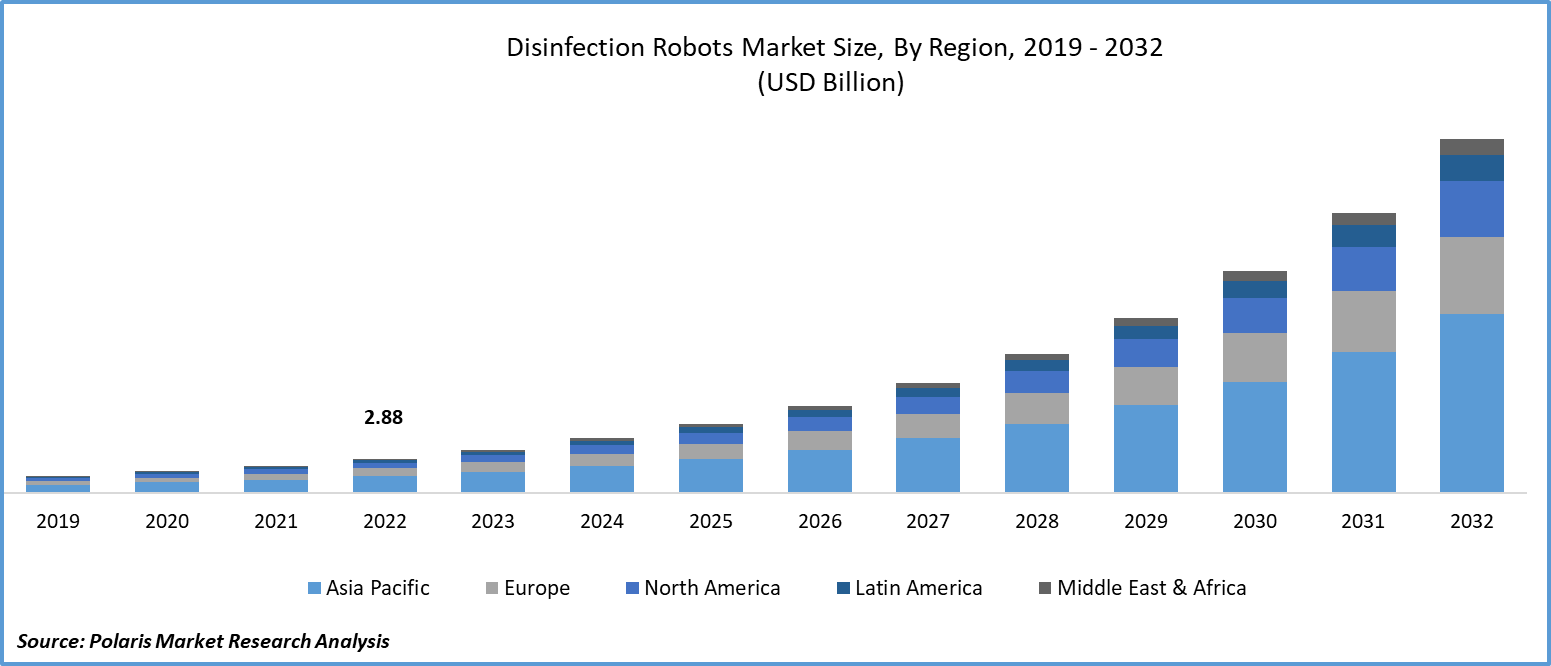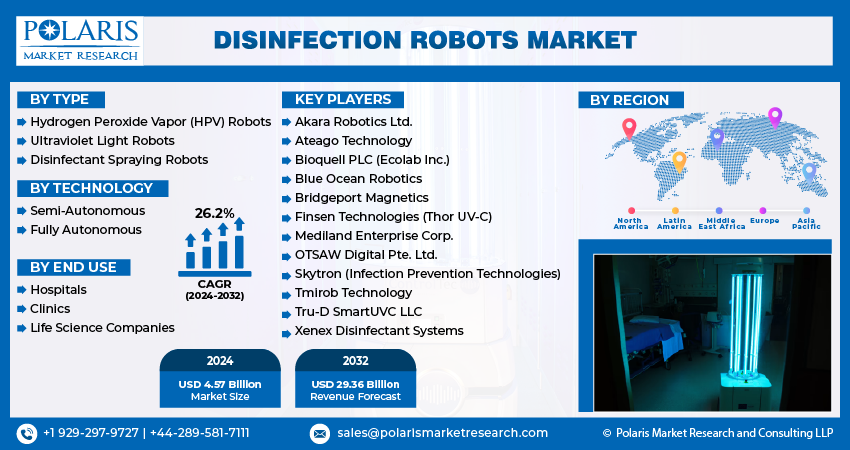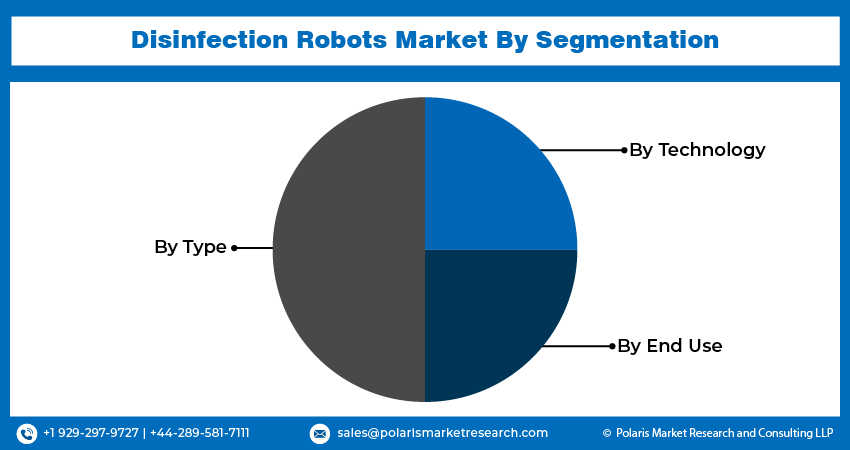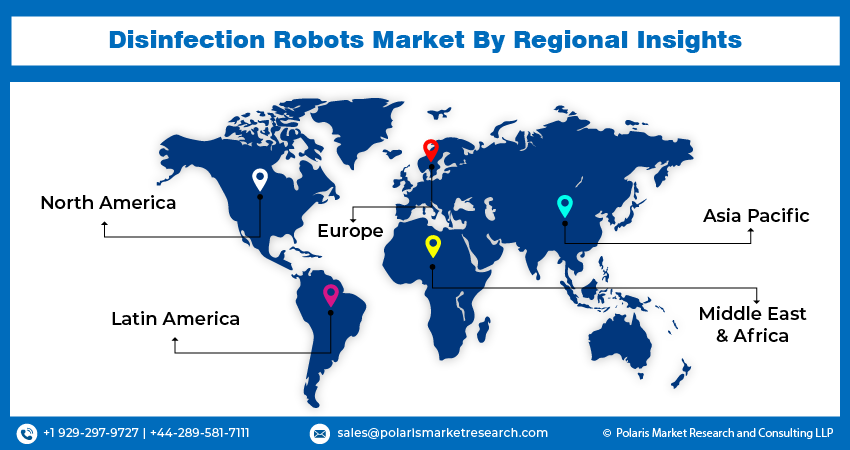
Disinfection Robots Market Share, Size, Trends, Industry Analysis Report
By Type (HPV Robots, Ultraviolet Light Robots), By Technology (Semi-autonomous, Fully-autonomous), By End-use (Hospitals, Clinics), And Segment Forecasts, 2024 - 2032
- Published Date:Jan-2024
- Pages: 115
- Format: PDF
- Report ID: PM4011
- Base Year: 2023
- Historical Data: 2019-2022
Report Outlook
The global disinfection robots market size and share was valued at USD 3.63 billion in 2023 and is expected to grow at a CAGR of 26.2% during the forecast period.
The growth of the market is driven by the growing awareness of hygiene and infection control in healthcare settings and the time-saving benefits offered by disinfection robots. Additionally, advancements in robotics and AI technologies have led to the development of advanced disinfection robots capable of navigating complex environments, adapting to different surfaces, and using various disinfection methods like UV-C light or chemical spraying. The urgency presented by infectious diseases like COVID-19 has further emphasized the demand for sophisticated disinfection techniques. These robots offer an efficient solution for rapidly covering large areas, thereby reducing the transmission of pathogens effectively.
A disinfection robot is a fascinating and well-planned kind of machine that is competent for disinfecting big rooms. This kind of robot is normally observed in hospitals, schools, shopping malls, and alternate buildings with escalated foot congestion that requires heedful disinfection. These robots do a marvelous job of warranting that each alcove of each room in a building is exhaustively disinfected.
Disinfection robots are excessively productive and efficient, which expounds their approval. They are capable of functioning without human assistance, rendering the human representatives of a building's neatness team capable of concentrating on more crucial chores. The disinfection robots market size is expanding as one can also initiate these robots to disinfect particular areas at specific times so that they will be established in a kind of eternal cycle of cleaning and disinfecting.

To Understand More About this Research: Request a Free Sample Report
Furthermore, hospital-acquired infections lead to approximately 37,000 deaths annually in Europe and nearly 100,000 in the U.S. Treating these infections places a significant financial burden, costing around USD 7.5 Bn in Europe & USD 6.5 Bn in the U.S. These robots emerge as a best solution, capable of eliminating upto 99.9 percent of micro-organisms within 10 minutes in a hospital room. The shortage of hospital workforce is another key factor propelling market growth. Due to rising demands, hospitals struggle to allocate sufficient staff for thorough cleaning & disinfection tasks. These robots bridge this gap by providing an automated and efficient solution.
These robots operate tirelessly and consistently, decreasing the need for manual labor in disinfection processes. By tackling the workforce shortage problem, disinfection robots guarantee that hospitals can uphold optimal cleanliness and infection control standards, leading to enhanced patient safety and operational efficiency. The rapid acceptance of disinfection robots, accelerated by the COVID-19 pandemic, has expanded their use from hospitals to various spaces like hotels, airports, and public transport. Additionally, the increase in antibiotic-resistant infections underscores the significance of infection prevention, particularly within medical facilities.
The disinfection robots market report is a comprehensive assessment of all the opportunities and challenges in the industry. It covers all the recent innovations and major events in the industry while shedding lights on the key market features such as CAGR, supply/demand, cost, production rate and consumption. Along with that, the study offers a thorough analysis of the key market dynamics and latest trends to help businesses develop strategies that will drive disinfection robots industry growth.

Nevertheless, despite the potential advantages of disinfection robots, there are hurdles to address. One of the primary concerns is the expenses associated with maintaining and deploying these advanced robots. While the initial costs are substantial, proponents argue that the long-term benefits in patient care and efficiency will outweigh the expenses. Additionally, there are worries about human job loss as robots assume more responsibilities. However, experts predict that incorporating mobile robotics will create new opportunities in system development, maintenance, and operation, mitigating potential job losses.
The market research report offers an in-depth analysis of the industry to support informed decision-making. It offers a meticulous breakdown of various market niches and keeps readers updated on the latest industry developments. Along with tracking the Disinfection Robots Market on the basis of SWOT and Porter’s Five Forces models, the research report includes graphs, tables, charts, and other pictorial representations to help readers understand the key insights and important data easily.
Industry Dynamics
Growth Drivers
- Increasing demand in hospitals to control the spread of infectious diseases effectively
The rapid growth of the disinfection robots market for disinfection robots is primarily fueled by the increasing demand in hospitals to control the spread of infectious diseases effectively. Hospitals and healthcare facilities have acknowledged the crucial role of these robots in creating a safe and sanitized environment for patients, staff, and visitors. Disinfection robots provide a dependable and efficient solution, capable of covering vast areas and reaching surfaces that are challenging for manual cleaning.
Their versatility in deploying various disinfection techniques, such as UV-C light or chemical sprays, enhances their ability to eliminate pathogens effectively. As hospitals emphasize infection prevention, the demand for disinfection robots continues to surge, driving substantial disinfection robots market growth. This trend is motivated by the necessity to ensure health and safety within medical settings.
Report Segmentation
The market is primarily segmented based on type, technology, end use, and region.
|
By Type |
By Technology |
By End Use |
By Region |
|
|
|
|
To Understand the Scope of this Report: Speak to Analyst
By Type Analysis
- Ultra-violet light robots segment accounted for the largest market share in 2022
Ultra-violet light robots segment held the largest revenue share. These robots utilize UV-C light, a type of ultraviolet light, to eradicate a wide range of pathogens, including bacteria, viruses, and other harmful microorganisms. Extensively studied for its germicidal properties, UV-C light can break down the DNA and RNA of pathogens, rendering them inactive. These robots offer consistent & thorough disinfection without the need for chemicals, thus reducing the risk of human error and potential exposure to harmful substances. Furthermore, UV robots can efficiently disinfect large areas, significantly cutting down the time required for manual cleaning and disinfection.
Furthermore, key players in the industry are enhancing market growth by developing and introducing highly advanced disinfection robots to maintain their competitive advantage. For instance, Taimi Robotics Technology, created TMiRob, a versatile disinfection solution incorporating three methods: UV, hydrogen peroxide, and plasma air filtration. These methods can be utilized individually or in combination, tailored to specific disinfection needs.
By Technology Analysis
- Autonomous robots segment held the significant market share in 2022
Autonomous robots segment held the majority market share. This is primarily due to their capacity to operate with minimal human intervention. These robots are equipped with advanced sensors, AI algorithms, and cameras, enabling them to independently navigate and disinfect spaces. This high level of autonomy guarantees consistent and efficient disinfection, minimizing the chances of human error and ensuring comprehensive coverage.
Fully autonomous robots possess the capability to map and adapt to their surroundings, avoiding obstacles and altering their cleaning methods accordingly. This technological progress not only improves the efficiency of disinfection but also leads to cost savings and time efficiency in operations. Consequently, there has been a growing demand for these fully autonomous disinfection robots, making them a popular choice for diverse industries in search of dependable and hands-free disinfection solutions.

Regional Insights
- Asia Pacific region dominated the global market in 2022
APAC emerged as the largest region. The industry's growth in the region is propelled by the introduction of advanced robots by the key players & rising government initiatives in the field of robotics. For instance, as per the Cutting Tool Engineering in January 2023 highlighted China's prominent position as the world's expanding robot industry. China's extensive technological adoption has the potential to significantly drive market growth in the region.
Furthermore, the growing recognition of the importance of maintaining stringent hygiene standards, particularly in response to the COVID-19 pandemic, has hastened the implementation of these robots throughout the region. For instance, in April 2020, hospitals in India embraced robotic solutions to reduce direct contact between COVID patients and healthcare providers, while also enhancing screening procedures. AIIMS hospital in Delhi, for instance, deployed floor disinfectant robots & humanoid robots in its COVID wards to efficiently oversee infection control measures.
North America region will grow rapidly. This growth is attributed to the region's highly advanced healthcare infrastructure and the increased investment by both the government and key market players to promote the use of robotics in healthcare settings.
For instance, in August 2020, Scripps Health, a nonprofit healthcare provider in San Diego, participated in Brain Corp.'s Robot Relief Program. This initiative involved providing cleaning robots and services to essential businesses during the health crisis. As part of this program, Scripps implemented robotic floor scrubbers at two of its facilities, including Scripps Memorial Hospital La Jolla and Scripps Mercy Hospital San Diego.

Key Market Players & Competitive Insights
Major industry players are focusing on strategic initiatives such as mergers, acquisitions, collaborations, partnerships, significant investments, and the launch of innovative products. These efforts aim to enhance their capabilities and expand their range of services. With the ongoing evolution of technologies like data analytics, machine learning, computer vision, and related fields, the medical service robotics sector is progressing towards higher efficiency and autonomy in task execution.
Some of the major players operating in the global market include:
- Akara Robotics Ltd.
- Ateago Technology
- Bioquell PLC (Ecolab Inc.)
- Blue Ocean Robotics
- Bridgeport Magnetics
- Finsen Technologies (Thor UV-C)
- Mediland Enterprise Corp.
- OTSAW Digital Pte. Ltd.
- Skytron (Infection Prevention Technologies)
- Tmirob Technology
- Tru-D SmartUVC LLC
- Xenex Disinfectant Systems
Recent Developments
- In January 2021, UBTECH has introduced its newest product, ADIBOT UV disinfection products, designed to offer hospital-grade disinfection for various facilities. This solution utilizes UV-C light to effectively eliminate COVID-19 as well as other harmful bacteria and viruses.
Disinfection Robots Market Report Scope
|
Report Attributes |
Details |
|
Market size value in 2024 |
USD 4.57 billion |
|
Revenue forecast in 2032 |
USD 29.36 billion |
|
CAGR |
26.2% from 2024 – 2032 |
|
Base year |
2023 |
|
Historical data |
2019 – 2022 |
|
Forecast period |
2023 – 2032 |
|
Quantitative units |
Revenue in USD billion and CAGR from 2024 to 2032 |
|
Segments covered |
By Type, By Technology, By End Use, By Region |
|
Regional scope |
North America, Europe, Asia Pacific, Latin America; Middle East & Africa |
|
Customization |
Report customization as per your requirements with respect to countries, region and segmentation. |
Gain profound insights into the 2024 Disinfection Robots Market with meticulously compiled statistics on market share, size, and revenue growth rate by Polaris Market Research Industry Reports. This thorough analysis not only provides a glimpse into historical trends but also unfolds a roadmap with a market forecast extending to 2032. Immerse yourself in the comprehensive nature of this industry analysis through a complimentary PDF download of the sample report.
Browse Our Top Selling Reports
Bottled Water Processing Market Size, Share 2024 Research Report
Data Center Solutions Market Size, Share 2024 Research Report
Industrial Networking Solutions Market Size, Share 2024 Research Report
Electric Mid- and Large (9-14m) Bus Market Size, Share 2024 Research Report
